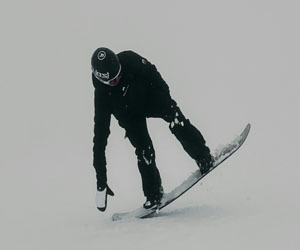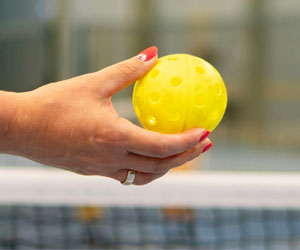


The Perfect Match

Pickleball, the dynamic and fast-growing sport that combines elements of tennis, badminton, and table tennis, is celebrated for its unique ability to strike a perfect balance between fun and competition. Whether you're playing casually with friends or competing in a high-stakes tournament, pickleball offers something for everyone. In this article, we'll explore how pickleball seamlessly combines fun and competition, making it a sport that appeals to players of all ages and skill levels.
Accessibility: Pickleball's approachability is one of its most attractive features. The sport's compact court size, straightforward rules, and slower-paced volleys make it accessible to players of all ages and fitness levels. This inclusivity ensures that both beginners and seasoned athletes can enjoy the game without feeling overwhelmed.
Social Aspect: One of the highlights of pickleball is the camaraderie it fosters. It's a sport where players frequently engage in light banter and laughter during play. The unique scoring system allows for rotation, ensuring that players regularly switch partners and opponents. This social interaction adds to the fun of the game and makes it a great way to meet new people.
Competitive Spirit: While pickleball can be a social and recreational pastime, it also offers a competitive edge that drives players to improve. Tournaments and rankings exist at various levels, motivating dedicated players to strive for excellence. The thrill of competition provides an exciting dimension to the sport.
Varied Skill Levels: Pickleball caters to players of varying skill levels. When recreational and competitive players come together on the court, it creates an opportunity for less experienced individuals to learn from their more seasoned counterparts. This mix of skill levels can lead to engaging and educational matches for all involved.
Flexibility: Players can easily adjust the intensity of a pickleball game to suit their preferences. In casual games, the emphasis is on fun, allowing for creative shots and playful rallies. As the stakes rise in competitive play, the focus shifts to precision and strategy. This adaptability makes pickleball suitable for a wide range of players.
Age Diversity: Pickleball is a sport where age is truly just a number. It's common to see players ranging from children to seniors competing on the same court. This diversity in ages adds to the sport's unique appeal, as it creates an environment where different generations can share their love for the game.
Healthy Competition: The competitive aspect of pickleball is conducive to personal growth. Players are encouraged to push their limits, improve their skills, and aim for higher rankings. The pursuit of excellence adds a layer of excitement and motivation, keeping the sport fresh and engaging.
Laughter And Lightheartedness: Pickleball has a remarkable ability to elicit laughter even in the most intense games. The joy of landing a perfect shot or the sheer unpredictability of the sport's dynamics often leads to moments of lightheartedness, reminding players that, above all, pickleball is meant to be fun.
Pickleball's ability to combine fun and competition is what sets it apart as a sport. The perfect blend of social interaction, inclusivity, and a dash of competitive spirit makes it a sport that's cherished by people of all backgrounds. Whether you're looking for a fun way to stay active or aiming to test your mettle in a competitive setting, pickleball has something to offer everyone. It's a sport that embraces the idea that, in the end, it's all about having a good time on the court.
Unleash Your Inner Shredder
 5. Perfect Your Buttering: Buttering is a stylish ground trick where you shift your weight and flex your snowboard to create fluid, spinning movements. It's a creative way to showcase your skills on the slopes and add some freestyle elements to your riding.
5. Perfect Your Buttering: Buttering is a stylish ground trick where you shift your weight and flex your snowboard to create fluid, spinning movements. It's a creative way to showcase your skills on the slopes and add some freestyle elements to your riding.
6. Progress To Rails And Boxes: Once you're comfortable with basic tricks, you can venture into the terrain park to try your hand at rails and boxes. These features provide opportunities for sliding and grinding tricks. Start with easy boxes and rails and work your way up as you gain confidence.
7. Work On Your Jibbing Skills: Jibbing involves riding on rails, boxes, and other terrain park features with style and control.
Key Sports Injury Prevention Principles
 1. Warm-Up And Cool-Down: The warm-up and cool-down routines are fundamental to injury prevention. A proper warm-up involves light aerobic exercises, dynamic stretching, and mobility drills to prepare the body for physical activity. The cool-down includes static stretching and gentle exercises to gradually decrease heart rate and prevent muscle tightness.
1. Warm-Up And Cool-Down: The warm-up and cool-down routines are fundamental to injury prevention. A proper warm-up involves light aerobic exercises, dynamic stretching, and mobility drills to prepare the body for physical activity. The cool-down includes static stretching and gentle exercises to gradually decrease heart rate and prevent muscle tightness.
2. Strength And Conditioning: Maintaining overall body strength and conditioning is crucial to injury prevention. A well-rounded strength training program helps stabilize joints, improve muscle balance, and enhance overall physical resilience.
Surfboard Designs For Beginners
 Longboards: The Stable Platform
Longboards: The Stable Platform
Longboards, often over 8 feet in length, are the classic choice for beginners. These surfboards provide unmatched stability and buoyancy, making them an ideal starting point. Key features of longboards for beginners include:
Length: Longboards are longer, which means more stability and room for paddling.
Width: Their width provides additional stability, making it easier for beginners to find their balance.
Volume: Longboards have ample volume, aiding in buoyancy and making it easier for novice surfers to catch smaller waves.
Longboards are perfect for learning the basics of paddling, balancing, and wave-catching. They offer a forgiving platform for new surfers, allowing them to gain confidence and experience the joy of riding waves.
Foam Boards: The Soft Landing
Foam boards, or soft-top surfboards, are another excellent choice for beginners. These boards are constructed with a soft, foam-covered deck, making them exceptionally safe for newcomers. Key features of foam boards include:
Safety: Foam boards reduce the risk of injury during falls, thanks to their soft construction.
Buoyancy: They offer sufficient buoyancy for easy paddling and wave-catching.
Stability: The wide and stable platform helps beginners find their balance.
Elevating Your Game
 Stacking: Stacking is a strategic positioning technique that can give your team a tactical advantage. By positioning yourselves in a specific formation on the court, you can exploit your opponents' weaknesses and create opportunities for aggressive plays. Stacking is particularly effective when you have players with different dominant hands or strengths.
Stacking: Stacking is a strategic positioning technique that can give your team a tactical advantage. By positioning yourselves in a specific formation on the court, you can exploit your opponents' weaknesses and create opportunities for aggressive plays. Stacking is particularly effective when you have players with different dominant hands or strengths.
The "Two-Up, Two-Back" Strategy: This strategic innovation emphasizes teamwork and court coverage. Two players move forward to control the net, while the other two players stay back to cover the baseline. This approach ensures that the net is controlled and that any balls hit deep to the back of the court are effectively covered. It's a great way to maintain a balanced defense and offense.
Cross-Court Dinking: Dinking, a short, soft exchange over the net, is a fundamental aspect of pickleball. Cross-court dinking involves hitting the ball diagonally across the net, which can be more challenging for your opponents to handle. This strategic innovation keeps your opponents off balance and opens up opportunities for unforced errors.
The Erne Shot: The Erne shot is a daring strategic move that involves leaping to the side of the court while your opponent is hitting a ball down the line. It's a high-risk, high-reward maneuver that can catch your opponent off guard and create open spaces on the court.
The Use Of Spin: Applying spin to the ball can add a new dimension to your game. Backspin can make it challenging for your opponent to control the ball, while topspin can give your shots more depth and accuracy. Learning to use spin effectively can be a game-changer.
Navigating The Thrills Of The Game
 2. Tactical Maneuvers
2. Tactical Maneuvers
Paintball adventure challenges often require tactical maneuvers to outsmart opponents and gain the upper hand. These maneuvers include flanking, taking cover, and setting up ambushes. Strategic thinking is essential to overcome your adversaries, seize key positions, and achieve objectives.
3. Objective-Based Challenges
Many paintball games involve specific objectives, such as capturing flags, defending positions, or retrieving items from the battlefield. These challenges add a layer of complexity to the game and demand teamwork, communication, and precise execution to succeed.
4. Ammo Conservation
Paintballs are a limited resource, and players must strategize to conserve their ammunition. Running out of paintballs can leave you vulnerable, so managing your shots effectively is a critical challenge in paintball adventures.
5. Precision Marksmanship
Achieving precision shots is not just a tactic; it's a significant challenge. Hitting your target requires excellent marksmanship skills, steady aim, and the ability to calculate trajectories, making every shot count.
6. Team Dynamics
Team dynamics is a fundamental challenge in paintball adventures. Players must work together seamlessly to coordinate their actions, communicate effectively, and support each other. Effective teamwork can make the difference between victory and defeat.
7. Tactical Adaptability
Adaptability is a key adventure challenge in paintball. The game can evolve rapidly, and players need to adjust their strategies on the fly. Being flexible and responsive to changing situations is essential for success.
A Timeless And Inclusive Pursuit
 Connecting Generations: Birdwatching provides a unique opportunity for intergenerational bonding. Grandparents can share their wisdom with grandchildren, passing on their love for birds and the outdoors. These shared experiences create lasting memories and strengthen family ties.
Connecting Generations: Birdwatching provides a unique opportunity for intergenerational bonding. Grandparents can share their wisdom with grandchildren, passing on their love for birds and the outdoors. These shared experiences create lasting memories and strengthen family ties.
Mental Stimulation: For older adults, birdwatching can be a mentally stimulating activity that keeps the mind active and engaged. Learning about birds, their behaviors, and their habitats can be intellectually rewarding. It also encourages older individuals to stay curious and inquisitive.
Physical Activity: Birdwatching often involves outdoor exploration, whether in a local park, nature reserve, or forest. This means gentle physical activity, such as walking and hiking, which can help maintain fitness and mobility, making it a healthy pastime for seniors.
Relaxation And Stress Reduction: For individuals of all ages, birdwatching offers a therapeutic escape from the stresses of daily life. The act of observing birds in their natural habitats can be a calming and meditative experience, reducing stress and promoting mental well-being.